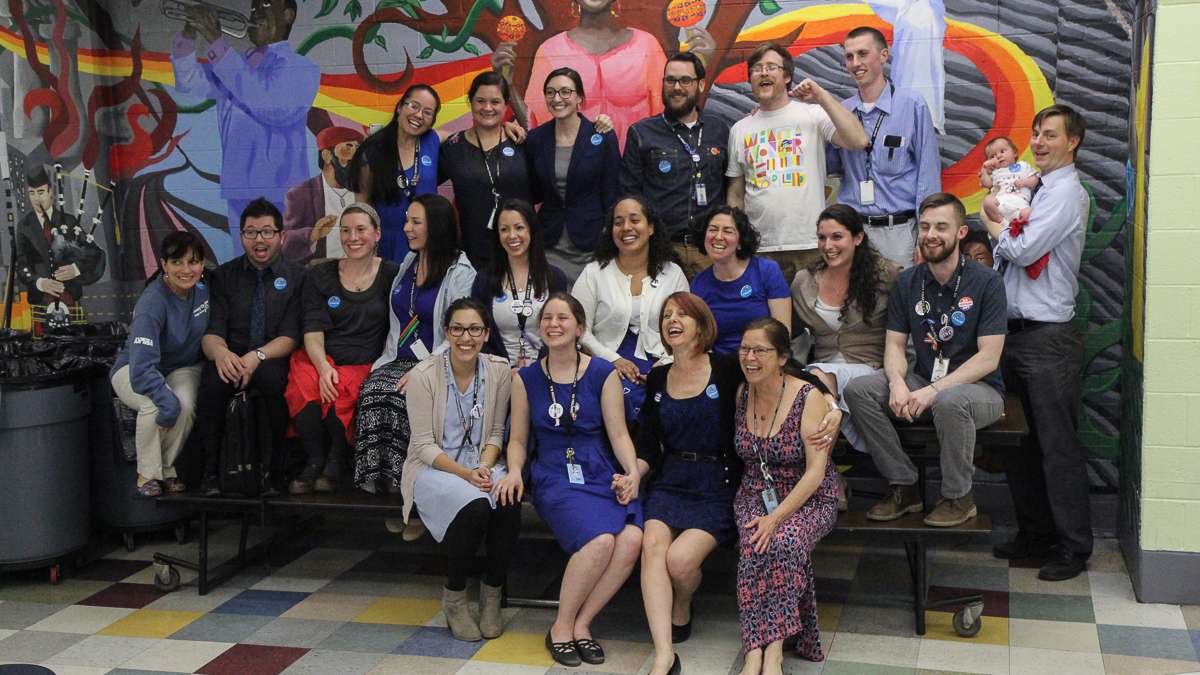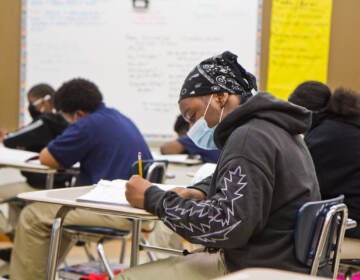Layoffs, deficit raise new questions about ASPIRA charters in Philly

Olney Charter High School teachers celebrate their vote to unionize in late April. Developments at the school since then have changed the mood dramatically.(Kimberly Paynter/WHYY)
A multimillion-dollar budget deficit and a round of layoffs have left Philadelphia School District officials with more questions than ever about the finances and management of one of its largest charter providers, ASPIRA Inc.
ASPIRA recently announced dozens of layoffs at Olney High School, a 1,600-student neighborhood Renaissance school in the Olney section of North Philadelphia. A total of 36 staff members were released – including 22 classroom teachers and 14 instructional aides – due to a $2.7 million deficit.
In the wake of those layoffs, which will increase class sizes from the low twenties to as many as 33 students per class, ASPIRA officials say they’re confident that the school can maintain its current levels of academic performance.
But teachers say that’s a dubious proposition, given the challenges of managing larger classes with diminished support for Olney’s neediest students.
And district officials say they’re actively investigating the origins of Olney’s current deficit, even as they continue to seek answers from ASPIRA about a number of other longstanding financial concerns. ASPIRA officials have said that Olney’s deficit springs from various changes in pension-funding laws, but district officials say they cannot confirm that at this time.
The stakes are high for ASPIRA, which runs five charters and has been held up by district officials as one of the city’s top-performing operators. It was hand-picked last year to take over the Muñoz-Marín Elementary school.
But that plan fell through when a parent vote rejected the provider; since then, district officials have found themselves increasingly concerned by its practices. In March, officials conceded that despite a number of attempts to get answers, they could not say they knew exactly how the nonprofit was spending its money.
At that time, they warned that if ASPIRA failed to address the district’s financial concerns, that could lead to a recommendation of non-renewal of the charter for Stetson Middle School this fall.
Now, officials are reiterating that message, indicating that little progress has been made since then and that the outcome for Stetson is far from assured.
What’s more, in the wake of the changes at Olney, district officials now say that poor academic outcomes and continuing financial questions there could eventually cost ASPIRA that school when its charter comes up for renewal in 2016.
Bigger classes, new faces, new struggles
For Olney’s teachers, the implications of this summer’s layoffs are clear: bigger classes and less support will mean less time focused on students’ needs, and more chances for them to fall through the proverbial cracks.
“It’ll be much tougher to give each student the attention they need,” said Derrick Houck, a math teacher in his fourth year at Olney. “It’s going to be jarring to students to change the instructional climate they’ve been used to … their classes are going to be packed. There will be new faces and new struggles.”
Of particular concern, he said, is the impact of the support staff cuts on special education students and English language learners. Each group represents about a quarter of the school’s population, he said, and the specialists’ assistance helped them keep pace with their peers.
“I think a student said it best,” Houck said. “Last time she came to a board meeting, she spoke in Spanish. This time she spoke in English, just to tell the board, ‘the only reason I’m speaking in English right now is because of the teachers I had at Olney.'”
Houck and other teachers were told about the cuts at the end of June, and they say the news came out of the blue. “I’ve been to board meetings regularly for the last three years, and whenever they talk about any of the schools’ budgets, no concerns like this have been brought up,” he said.
“I never heard layoffs discussed. I never heard these drastic changes discussed,” he said.
Details of exactly what was cut and what might be replaced are still emerging, he said. (Staff have been told that some special education services will be outsourced, for example.)
But even as he hopes for the best, he and other teachers remain skeptical of the school’s claim that the deficit springs from changes in pension reimbursement policies; they wonder if the cuts aren’t related to the staff’s attempts to organize a union, a move that ASPIRA has staunchly opposed.
“Why is this not happening at other ASPIRA schools?” Houck said. “Olney’s the only school we know of that’s facing these cuts. The only difference between us and those schools that we know of is that we voted to unionize this year. So, yeah, that’s in the back of our minds.”
Emma Restrepo, a spokeswoman for ASPIRA, countered that Olney’s deficit was mainly the result of the need for increased contributions to PSERS, the teachers’ retirement fund, and that teachers were first told of the issue last year.
“When the extra costs of PSERS benefits were added to our budget recently, overstaffing became unsustainable and no longer a benefit to the overall quality of education,” she said.
Another factor was a pay hike for teachers, she said, and teachers were informed of that as well.
“We … informed them that increasing salaries under the current budget would only increase the deficit,” Restrepo wrote. “They responded to that information by stating that they still wanted to be provided with increases, which they were.”
Restrepo said ASPIRA is confident it has chosen its staff cuts wisely.
“We were overstaffed in terms of instructional personnel,” she wrote, due to lower-than-anticipated enrollment. “We took great care to leave as many of the core instructional staff as possible intact. We focused on reducing overlapping or redundant positions and consolidating support in other areas.”
Despite concerns like Houck’s, Restrepo said that, in the past, most Olney classes were underenrolled. Even with the cuts, she said, most are currently rostered at fewer than 30 students. ASPIRA “will do whatever is necessary to fulfill this while working with our annual budget,” she wrote. “We’re confident our actions will mean a great school year.”
Many questions, few answers
District officials don’t share Restrepo’s confidence.
Not only are they uncertain of the impact of the current cuts at Olney, they’re uncertain about the origins of the deficit that made the cuts necessary. The district has longstanding concerns about certain financial practices within ASPIRA’s parent organization – most notably, its habit of having multiple subsidiaries with interlocking boards loan each other money – and last spring, it gave ASPIRA a long list of reforms it wanted to see before it could recommend the school’s charter for renewal.
ASPIRA’s Restrepo said those reforms, 17 in all, had been successfully addressed.
“Some of these issues, many of which arose out of misinformation, included reference to events that never took place,” she wrote. “ASPIRA of PA addressed all 17 points completely, and it is our understanding that the district was satisfied with the answers.”
District officials said that’s not the case.
“We plainly disagree,” spokesman Fernando Gallard said. “These are factual concerns. ASPIRA did reply to our letter [requesting reforms], but not to our full satisfaction. So there’s still a number of issues they need to fully reply to, and we’re still working with them on that.”
Asked if it was possible that Olney’s current deficit was connected to any of the financial practices that have raised concerns in the past, Gallard said the district doesn’t know, but it would like to find out.
“We’re asking for further information info from ASPIRA on that specific issue,” Gallard said. “It is too early for us to tell if there is a connection. But we are actively pursuing more information, to see what is going on.”
The Olney questions arise as the district prepares to make a recommendation about Stetson. The North Philadelphia school’s charter will be considered for renewal this fall, and district officials have told ASPIRA that failing to address the district’s financial concerns could put that charter in jeopardy.
Asked if ASPIRA had been cooperative when it came to providing information and addressing concerns, Gallard demurred. “What I can tell you is that this renewal process has taken much longer than usual,” he said. “It’s a very complicated situation, and there’s a lot of issues to look at.”
But in addition to Stetson, the district will be watching how things play out at Olney, he said, and keeping the results in mind when that charter next comes up for review in 2016.
“We will be looking at what is going to occur there,” Gallard said. “Looking at how the deficit and the cuts have affected education for students is tremendously important to us …. it’s going to be reflected in their renewal recommendation coming from the charter school office if these issues are not resolved.”
Meanwhile, Houck said he and other teachers will be keeping in touch, trying to stay abreast of the unfolding changes, and keeping an eye on Olney’s other big question mark: the empty seat in the principal’s office. Former principal José Lebrón stepped down just as the layoffs were announced (due to what ASPIRA said are more PSERS-related complications, connected to Lebrón’s status as a retired district principal), and no replacement has been announced.
But the school’s next leader will find a “hard-working staff that is eager to get behind a mission,” Houck said. “We’ve created a lot of programs of our own over the last four years. There’s a lot of ground work that’s been done. A lot of staff that have been around and are invested in the school.”
WHYY is your source for fact-based, in-depth journalism and information. As a nonprofit organization, we rely on financial support from readers like you. Please give today.




